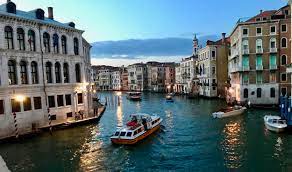Italy: Very lively in Venice – Having a ball in the city of water

Ilena Ilardo
Venice: Every Italian has their favourite region of their home country they believe to be aesthetically and culturally superior. Part of the reason is the dizzying variety of culture, cuisine and architecture, which differs dramatically from region to region, the result of foreign invasions that chopped up the boot-shaped country a dozen centuries ago. But even against this backdrop, Venice is something else.
Italy’s historical maritime power has dominated the column inches these past weeks due to a certain Brit whose surname rhymes with “miles”. I didn’t personally meet him when I visited during the famous Venice International Film Festival, but luckily there is plenty more to get excited about. Venice looks exactly like it does in those glossy Instagram posts where celebs recline on yachts. It’s glamorous and cool and utterly unlike anywhere else.

I navigated the winding canals on a vaporetto, essentially a waterborne bus. I made my way from Santa Lucia railway station to Rialto, Venice’s first bridge which, according to legend, could only be completed once the devil had claimed the soul of the first living being who crossed it. Architect Da Ponte allegedly outsmarted the devil by having a cockerel walk over the bridge instead – sucks for you, cockerel.
Venice’s oldest hotel, the Baglioni Luna, is a 10 minute walk from Rialto – or a little longer by gondola – right at the entrance of St Mark’s Square. The building used to be owned by the Order of the Templars before the Pope gave permission to sell it, at which point, in 1312, it became a hostelry, the Osteria Luna. The hotel eventually made the ‘luna’, the Venetian moon, its hallmark.
Moonlight and dim lampposts are part of Venice’s gloomy charm, so with its extensive redesign earlier this year, the Baglioni Luna wanted to pay tribute to the dark corners of the city by installing soft wall lights throughout the hotel – except for in its Marco Polo Ballroom, which is decorated with decadent glass chandeliers that illuminate the historic ceilings frescoes. A luscious breakfast buffet is served here every morning and it comes highly recommended.

That evening the hotel bar had teamed up with Camparino in Galleria, one of the world’s 50 best bars, to host a cocktail pop-up to celebrate the film festival. There I sipped one of the tastiest tipples I have ever had: Compadre, a Campari signature cocktail made with Chinotto liqueur, agave, Vermouth and Angostura, which arrived amid a billowing cloud of smoke.
At the bar I was introduced to Giovanni, whose family have owned venetian taverns for five generations. Giovanni told me that in life there are three things you can never do: have a full barrel and a drunk wife – the Italian version of not being to have your cake and eat it –, make everyone like you, and get things back to the way they were.
This is a very dramatic introduction to one of Giovanni’s passions: cicchetti, the typical Venetian street food. Giovanni says that during the First World War cicchetti were served with bread on the side – apparently men thought that eating plain cod or, even better, with “plenty of onions”, would mean their wives couldn’t smell the alcohol on them. Today the cicchetti are served on baguettes.
After much deliberation Giovanni agreed to share with me his recommendations for the best places to eat authentic Venetian street food, which included Cantina Do Mori, All’Arco, I compari, Bancogiro, and Estro.
Giovanni also lectured me on Venetian wines, which came in handy the following day when I visited the Venissa Wine Resort in Mazzorbo – around 40 minutes away from the main island, accessible via waterboat number 12 – where some 4,000 specimens of Dorona, a rare native grape from Venice, welcomed me to the island.
I met Valeria, part of the friendly Venissa team, in a vineyard surrounded by medieval walls and traditional colourful houses. During lunch at the Resort’s Osteria Contemporanea, where I ate more mind-blowing cicchetti, she explained how Venissa is a project of “agricultural rejuvenation” and its white wines, Venissa and Venusa, are products of the intricate balance of the salty Venetian lagoon. But the unnatural drought plaguing Europe has also hit Mazzorbo, and the effects on vineyards that try to follow a ‘natural’ cycle have been particularly devastating.
Upon return, I threw myself back into the third millennium by joining a party celebrating 50 years of the Godfather at the Ca’ di Dio, a movie-themed aperitivo bar that offered cigars and pastry balls filled with veal and tuna sauce. Then I had one for the road at Harry’s Bar, the classic meeting point for intellectuals and free-thinkers including Orson Welles, Truman Capote, Ernest Hemingway and, most recently, I.
On the last day of my stay I visited the Biennale art exhibition held in Castello, in the halls of the Arsenale and Biennale Gardens. The exhibit featured some of the best pieces of contemporary art from all over the world, including my favourite, Gian Maria Tosatti’s History of Night and Destiny of Comets. It’s an installation that features landscapes of silent and alienating factories in which the human presence has disappeared, ending with a vision of a nocturnal sea, an expanse of dark water with dozens of ‘fireflies’ in the distance. The piece is inspired by a quote from Pierpaolo Pasolini, Italy’s greatest and most controversial poet and director: “I would give the whole Montedison [one of the biggest Italian industrial groups] for a firefly”.
Pasolini was often slammed for going against public decency and was actually tried for obscenities at the Court of Venice in 1968 as the author of the movie Teorema. In this year’s edition of the film festival, the Classics section features the restoration of this same movie, while Pasolini’s boat Edipo Re is today home to the best festival after-parties.
This revisionism is emblematic: Venice has a historical reputation for being stiff and intransigent. Locals I met told me they worry this is still Venice’s perception globally – an old, pompous lady not fitting in with modern times. But after a fantastic three days here it’s clear to me that all the ‘City of Water’ needs in order to be loved is to be itself.





